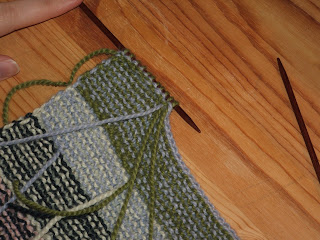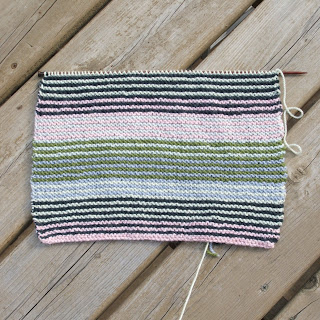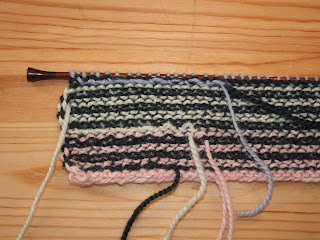This time around, I have two goals: (1) have a more solid cast-on to complete the neck shaping and (2) have the line between sweater front and sweater back lie between two garter ridges rather in the middle of one.
Here, I decided to bind off on a WS row and cast on on the following RS row to place the neck opening between two garter ridges. In order to have a more solid cast on, I will join an extra strand of the working color on the cast on row so that I can work a long-tail cast on instead of the backwards loop cast on called for by the pattern. How? Watch and see. Look here for my tutorial on knitting in ends.
I bound off with a periwinkle stripe and now am starting a green stripe for the cast on row. In my right hand I have the working yarn and the tail end of the yarn from the other end of the ball.

In my left hand I have the yarn from the end of the ball and the tail of the now-discarded periwinkle from the previous row that need to be woven in. As I work the next X stitches (11 in my case), I knit in the purple and second green strands.
Once the 11 stitches are worked I have two strands of green waiting for me at the left side of the right hand needle:

See the back:

Now, since I have two strands of green at my disposal, I can work a long-tail cast on for Y stitches as called for by the pattern (38 in my case).

The long-tail cast on is the equivalent of a backwards loop cast on followed by a row of knitting. It is that extra stitch (or rather its equivalent in the long-tail cast on) that makes the cast on more secure.

Once I have cast on my Y stitches, I knit in the extra strand (the one from the outside of the green ball) across the last (X-1) stitches of the row. See the tail where I have cut off the extra:

I work the next row across in the green to finish off the neck (technically it was done at the end of the last row) by knitting across the side stitches and the new cast on stitches for the other side of the neck.

Now all I have to do is keep working the stripes in pattern until the two sides of the neck opening are the same length. The tricky part is done. See: a neck.
















